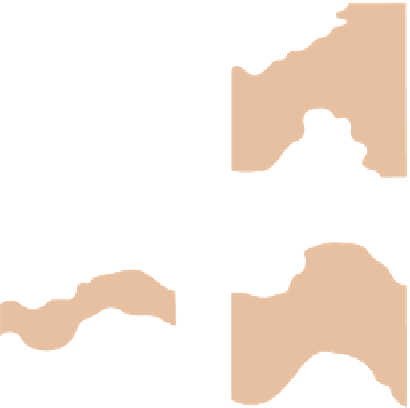Geoscience Reference
In-Depth Information
Manaus (Brazil), 44m
(
a) Africa
(b
) India
40
20°N
20°N
Highest
35
10°N
10°N
Mean max.
30
Eq
Eq
25
Mean min.
10°S
10°S
20°S
20°S
20
Lowest
JFMAMJJASOND
JFMAMJJASOND
250
(c) W. Pacific
(d) C. Pacific
200
20°N
20°N
150
10°N
10°N
Mean annual
precipitation - 1811 mm
100
Eq
Eq
50
10°S
10°S
0
20°S
20°S
J F M A M J J A S O N D
JFMAMJJASOND
JFMAMJJASOND
Figure 27.3
Climatic data for Manaus, Brazil.
(e) E. Pacific
(f) S. America
20°N
20°N
should be. The processes operating on Earth's surface
have been identified in
Chapters 10-
15. I
n the tropics the
intensity of these processes will be different from that
in other environments, though it is difficult to prove
that these generate landforms or landscapes specifically
tropical.
Many parts of the tropics are based on relatively stable
continental plates. Such areas have not been exposed to
glaciation and therefore weathered material has been able
to accumulate rather than being dispersed, as happened
in many parts of the temperate and subpolar lands. In
extreme cases the weathering horizon may be as deep
as 30 m in the more humid tropics, though its depth
decreases where moisture is less available and normal
depths are about 3 m. How long such weathering horizons
have been developing is difficult to decipher but many
are believed to be long established. In the more tectoni-
cally active areas, such as Indonesia, volcanism can bury
existing weathering horizons. The new lava is then rapidly
weathered in turn. Erosion of the weathered material may
take place through fluvial processes or by mass movement.
Where slopes are steep, this may be significant, but on
gentler slopes the density of biomass produces a protective
zone on which slope movement is slow. One of the most
important processes of the tropics is run-off. Most of the
material eroded from the humid forest is carried by run-
off in the form of solution. Little coarse sediment moves
as bed load, but the density of vegetation prevents all
except the finest particles being carried by overland flow.
Only bank erosion will produce a sudden increase in the
amount of sediment transport.
10°N
10°N
Eq
Eq
10°S
10°S
20°S
20°S
JFMAMJJASOND
JFMAMJJASOND
(g) Atlantic
(h) Global
20°N
20°N
10°N
10°N
Eq
Eq
10°S
10°S
20°S
20°S
JFMAMJJASOND
JFMAMJJASOND
4 or more
1 - 4 days
no HRC
identified by areas of highly reflective cloud (HRC).
Source: After Waliser and Gautier (1993)
Studies do not support the idea of a uniform level of
weathering or of landforms in the humid tropical zone.
What we would expect on the basis of climatic conditions
is deep weathering caused by the higher rates of chemical
processes at warmer temperatures where moisture is
available; the wetter an area is, the deeper the weathering































































































































































































































































































































































































































